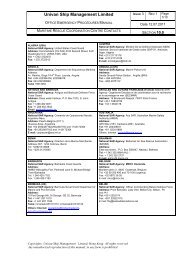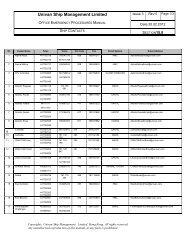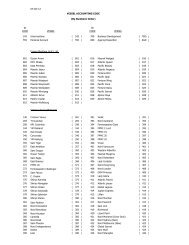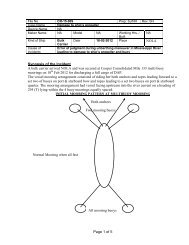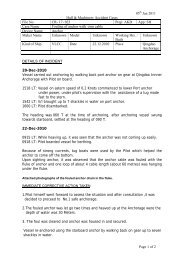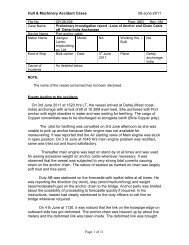Section: 11 CARGO OPERATIONS - Univan
Section: 11 CARGO OPERATIONS - Univan
Section: 11 CARGO OPERATIONS - Univan
Create successful ePaper yourself
Turn your PDF publications into a flip-book with our unique Google optimized e-Paper software.
<strong>Univan</strong> Ship Management Limited Issue 1 REV 0 Page<br />
2/2<br />
FLEET OPERATION MANUAL Date 01.01.2005<br />
CONTAINER <strong>CARGO</strong>ES – HEAVY WEATHER PRECAUTIONS<br />
On deck:<br />
20 ft containers should always be locked by loading 40 ft containers on top<br />
Copyrights: <strong>Univan</strong> Ship Management Limited, Hong Kong. All rights reserved<br />
Any unauthorized reproduction of this manual, in any form is prohibited<br />
SECTION <strong>11</strong>.10<br />
10. The securing foundations must be checked. If unsatisfactory they must be repaired as soon<br />
as possible, starting with outer slots.<br />
A record of inspection of foundations should be maintained. Foundations should be visually<br />
checked when ever accessible. Necessary repairs must be carried out. Outer rows must be<br />
attended immediately. Visual examination should be particularly stringent after heavy<br />
weather. Ensure that foundation drain holes are not blocked. Accumulation of water will<br />
corrode and weaken the foundation.<br />
<strong>11</strong>.Hatch covers’ securing arrangements should be in good order. Proper<br />
securing of hatch covers should be ensured prior loading containers on<br />
top.<br />
12.On multi purpose carriers or vessels without cell guides in holds, heavy<br />
racking stresses can be experienced which can cause collapse of a full<br />
stack. Clear instructions, as mentioned in lashing plans and securing<br />
manuals must be followed. These may include, but not be limited to the<br />
following:<br />
a) Number of tiers of containers to be loaded with tween decks closed or open.<br />
b) Securing of under-deck containers with chocking units and / or bridge<br />
fittings.<br />
Please remember lashing chains have do not provide necessary strength as provided by lashing<br />
bars.<br />
13. Non standard cargo should be stowed inboard rather than on outer rows.<br />
14. A correct record of lashing material must be maintained. Damages, if any, must be<br />
notified to charterers as soon as possible. We frequently land up with serious short falls with no<br />
record. Owners have had to supply lashing material at their cost on many occasions when<br />
actually they should have been supplied by charterers. This is mainly due to improper<br />
records/notification.<br />
15. Most important of all:<br />
Lashings must be tended daily and same logged down. The turnbuckles lock nuts must be<br />
screwed tight right up to the turnbuckle tube or the body. Lashing gangs invariably have habit of<br />
loosening these lock nuts all the way down and never tighten these when taking lashings.<br />
Crew must be made trained and specifically instructed about lashing systems on board. Chief<br />
officers and masters are requested to make checks to confirm that lashings are satisfactorily<br />
taken.<br />
Please start lashing check register where all duty officers and the crew who check lashing must<br />
confirm by signing. Random rounds by Master and Chief Officer, particularly after departure port,<br />
to confirm that lashings are correctly taken will help prevent such losses.<br />
Crew must be made responsible of their lashing duties. This is the Masters’ and Chief Officers<br />
responsibility - Safe transportation of cargoes.



